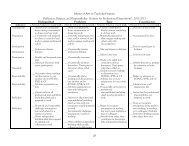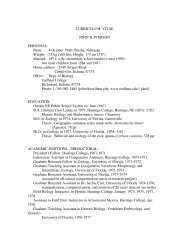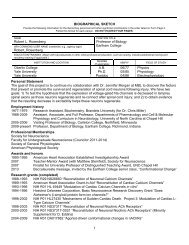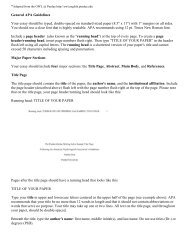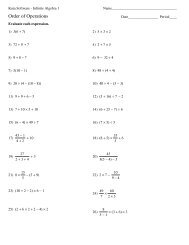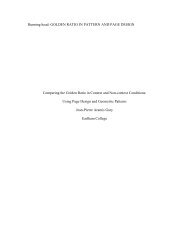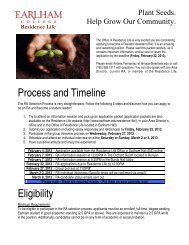IGUANAS OF THE WORLD Family Iguanidae Subfamily Iguaninae ...
IGUANAS OF THE WORLD Family Iguanidae Subfamily Iguaninae ...
IGUANAS OF THE WORLD Family Iguanidae Subfamily Iguaninae ...
You also want an ePaper? Increase the reach of your titles
YUMPU automatically turns print PDFs into web optimized ePapers that Google loves.
<strong>IGUANAS</strong> <strong>OF</strong> <strong>THE</strong> <strong>WORLD</strong><br />
<strong>Family</strong> <strong>Iguanidae</strong><br />
<strong>Subfamily</strong> <strong>Iguaninae</strong><br />
Checklist compiled by John B. Iverson and based primarily on Etheridge (1982) and<br />
Hollingsworth (2004). Content: Nine living genera and 42 living species are currently<br />
recognized; however, undescribed species are known to exist (e.g., see Zarza et al. 2008; Malone<br />
and Davis 2004; Gentile et al. 2009). Comment: This assemblage of relatively large, mostly<br />
herbivorous iguanas has long been recognized as being monophyletic (all derived from a single<br />
common ancestor). As such, most scientists have classified the group in the subfamily <strong>Iguaninae</strong><br />
of the family <strong>Iguanidae</strong> (Schulte et al. 2003; Pough et al. 2004; Vitt and Caldwell 2009),<br />
although some recent authors (e.g., Frost et al. 2001; Hollingsworth 1998, 2004; Conrad 2008)<br />
have elevated the iguanas to full family status. Distribution: New World tropics and subtropics<br />
including the West Indies and Galápagos Islands, and the Fiji-Tonga Islands. Comment:<br />
Considerable controversy surrounds the phylogenetic relationships among the genera in this<br />
family (e.g., see Hollingsworth 2004).<br />
Amblyrhynchus Bell [Galápagos Marine Iguanas]<br />
Amblyrhynchus Bell 1825, Zool. Jr., London 2:206. Type species (by monotype):<br />
Amblyrhynchus cristatus Bell 1825. Distribution: Galápagos Islands.<br />
Amblyrhynchus cristatus Bell [Galápagos Marine Iguana]<br />
Original name: Amblyrhynchus cristatus Bell 1825, Zool. Journal, London 2:206. Holotype:<br />
OUM 6176 (Etheridge 1982). Type locality: "Mexico." Corrected type locality: “Narborough<br />
(Fernandina)” (Eibl-Eibesfeldt 1956). Distribution: Galápagos Archipelago. Comment: Most<br />
authors have not used subspecific epithets, although they have not been formally synonymized<br />
(see Rassmann et al. 1997).<br />
Amblyrhynchus cristatus cristatus Bell [Fernandina Marine Iguana]<br />
Original name: Amblyrhynchus cristatus cristatus Bell. See species account.<br />
Distribution: Narborough (Fernandina) Island, Galápagos Archipelago.<br />
Amblyrhynchus cristatus albermarlensis Eibl-Eibesfeldt [Isabella Marine Iguana]<br />
Original name: Amblyrhynchus cristatus albermarlensis Eibl-Eibesfeldt 1962,<br />
Senckenberg. Biol., Frankfurt a. Main 43(3):184. Holotype: Eibl-Eibesfeldt private coll.<br />
(Etheridge 1982). Type locality: "Insel Albemarle (Isabella)." Distribution: Albemarle<br />
(Isabella) Island, Galápagos Archipelago.<br />
Amblyrhynchus cristatus hassi Eibl-Eibesfeldt [Santa Cruz Marine Iguana]
Original name: Amblyrhynchus cristatus hassi Eibl-Eibesfeldt 1962, Senckenberg. Biol.,<br />
Frankfurt a. Main 43(3):181. Holotype: SMF 57407. Type locality: "Indefatigable<br />
Südküste, westliche Akademiebucht…Indefatigable (Santa Cruz), Galápagos-Inseln."<br />
Distribution: Indefatigable (Santa Cruz) Island, Galápagos Archipelago.<br />
Amblyrhynchus cristatus mertensi Eibl-Eibesfeldt [San Cristóbal Marine Iguana]<br />
Original name: Amblyrhynchus cristatus mertensi Eibl-Eibesfeldt 1962, Senckenberg.<br />
Biol., Frankfurt a. Main 43(3):185. Holotype: SMF 57430. Type locality: "etwa 3 km<br />
südwestlich der Wrack-Bucht der Insel Chatham (S. Cristobal)…Chatman (Chatham [S.<br />
Cristobal]), Galápagos-Inseln." Distribution: Chatham (San Cristobal) and James<br />
(Santiago), Islands, Galápagos, Archipelago.<br />
Amblyrhynchus cristatus nanus Garman [Genovesa Marine Iguana]<br />
Original name: Amblyrhynchus nanus Garman 1892, Bull. Essex. Inst. 24:8 Holotype:<br />
BMNH 99.5.4 = BMNH 1946.8.30.20 (Etheridge 1982). Type locality: “Tower Island”<br />
[Galápagos]. Distribution: Tower (Genovesa) Island, Galápagos Archipelago.<br />
Amblyrhynchus cristatus sielmanni Eibl-Eibesfeldt [Pinta Marine Iguana]<br />
Original name: Amblyrhynchus cristatus sielmanni Eibl-Eibesfeldt 1962, Senckenberg.<br />
Biol., Frankfurt a. Main 43(3):188. Holotype: SMF 57417. Type locality: "Westküste<br />
der Insel Abingdon." Distribution: Abingdon (Pinta) Island, Galápagos Archipelago.<br />
Amblyrhynchus cristatus venustissimus Eibl-Eibesfeldt [Española Marine Iguana.]<br />
Original name: Amblyrhynchus cristatus venustissimus Eibl-Eibesfeldt 1956,<br />
Senckenberg. Biol., Frankfurt a. Main 37:90. Holotype: SMF 49851. Type locality:<br />
"Nordküste der Insel Hood (Española)." Distribution: Hood (Española) and Gardner<br />
Islands, Galápagos Archipelago.<br />
Brachylophus Cuvier [Fiji Iguana]<br />
Original name: Brachylophus Cuvier 1829, in Guérin-Ménville, Icon. Règ. Anim., Paris 1:9.<br />
Type species (by monotypy): Iguana fasciata Brongniart 1800. Distribution: Fiji and Tonga<br />
Islands. Comment: Based on Keogh et al. (2008) B. fasciatus is the sister species to the clade<br />
including B. vitiensis and B. bulabula; furthermore unpublished moelcular studies (Fisher et al.<br />
2009) suggest that a fourth species may exist.<br />
Brachylophus bulabula Fisher, Harlow, Edwards, and Keogh in: Keogh, Edwards, Fisher, and<br />
Harlow [Fijian Banded Iguana]
Original name: Brachylophus bulabula Fisher, Harlow, Edwards, and Keogh in: Keogh,<br />
Edwards, Fisher, and Harlow 2008, Phil. Trans. Royal Soc. B. 363(1508):3419. Holotype:<br />
CAS 172524. Type locality: “Navuloa Village, Ovavlau Island, Republic of Fiji (17°42’05.95”<br />
S, 178°45’42.12” E)”. Distribution: Larger northwestern islands of the Viti Group of Fijian<br />
islands, including at least Ovalau, Gau, Kadavu, and Vit Levu. Comment: Although the recent<br />
description of this species clarifies the taxonomy in this genus, the correct identification of the<br />
species occuring on many islands is not yet certain. This is complicated by introductions of<br />
these iguanas onto non-native islands.<br />
Brachylophus fasciatus (Brongniart) [Lau Banded Iguana]<br />
Original name: Iguana fasciata Brongniart 1800, Bull. Soc. Philom., Paris 2:90. Holotype:<br />
none designated. Type locality: none given; “Tonga”, according to Keogh et al. (2008).<br />
Distribution: Lau island group of Fiji Islands, including at least Lakeba, Aiwa, Oneata, and<br />
Moce.<br />
Brachylophus vitiensis Gibbons [Fijian Crested Iguana]<br />
Original name: Brachylophus vitiensis Gibbons 1981, J. Herpet. 15(3):257. Holotype: MCZ<br />
157192. Type locality: "Yaduataba island (16°50' S; 178°20' E), Fiji." Distribution: Fiji Island<br />
Group, found on the island of Yadua Taba and (presumably) the northern islands of the<br />
Yasawa group.<br />
Cachryx Cope [Yucatán Spiny-tailed Iguanas]<br />
Original name: Cachryx Cope 1866, Proc. Acad. Nat. Sci. Philadelphia 18:124. Type species (by<br />
monotypy): Cachryx defensor Cope 1866. Distribution: Yucatán Peninsula, Mexico. Comment:<br />
The recognition of this genus (long synonymized with Ctenosaura) is the result of molecular<br />
phylogenetics studies by Catherine Stephens et al. (in prep.).<br />
Cachryx alfredschmidti (Köhler) [Campeche Spiny-tailed Iguana]<br />
Original name: Ctenosaura alfredschmidti Köhler 1995, Salamandra 31(1):5. Holotype: SMF<br />
69019. Type locality: "70 km östl. von Escarcega auf der Straße nach Chetumal, Campeche,<br />
Mexico." Distribution: Known only from the type locality on the Yucatán peninsula, in the<br />
Mexican state of Campeche.<br />
Cachryx defensor Cope [Yucatán Spiny-tailed Iguana]<br />
Original name: Cachryx defensor Cope 1866, Proc. Acad. Nat. Sci. Philadelphia 18:124.<br />
Syntypes: USNM 12282 [3 specimens] (Bailey 1928; de Queiroz 1995). Type locality: not<br />
given; Yucatán, by implication (de Queiroz 1995). Restricted type locality: “Chichén Itzá,<br />
Yucatán, Mexico” (Bailey 1928); inappropriate restriction (de Queiroz 1995). Distribution:<br />
Yucatán Peninsula from Campeche to Yucatán.
Conolophus Fitzinger [Galápagos Land Iguanas]<br />
Original name: Hypsilophus (Conolophus) Fitzinger 1843, Syst. Rept., Wien 1:55. Type species<br />
(by original designation) Amblyrinchus Demarlii Duméril and Bibron 1837 = Amblyrhynchus<br />
subcristatus Gray 1831). Distribution: Galápagos Islands. Comment: Tsika et al. (2008) and<br />
Gentile et al. (2009) have demonstrated that this genus includes five evolutionarily significant<br />
units, only three of which have been described.<br />
Conolophus marthae Gentile and Snell [Galápagos Pink Land Iguana]<br />
Original name: Conolophus marthae Gentile and Snell 2009, Zootaxa, 2201:1. Holotype: A<br />
free-living adult male with a Passive Intergated Transponder #091-601-303. Type locality:<br />
"approximately four km north of the Equator on the top of Volcan Wolf, Isla Isabela Galápagos<br />
National Park, Ecuador (0.03792° N; 91.36324°W, datum WGS84." Distribution: Volcan Wolf,<br />
northern Isla Isabela, Galápagos Archipelago. Comment: Additional support for the recognition<br />
of this species appeared in Tsika et al. (2008) and Gentile et al. (2009).<br />
Conolophus pallidus Heller [Santa Fe Island Iguana]<br />
Original name: Conolophus pallidus Heller 1903, Proc. Wash. Acad. Sci., 5:87. Holotype:<br />
CAS-SU 4749. Type locality: "Barrington [= Santa Fe] Island, Galápagos Archipelago."<br />
Distribution: Santa Fe (= Barrington) Island, Galápagos Archipelago.<br />
Conolophus subcristatus (Gray) [Galápagos Land Iguana]<br />
Original name: Amb. [lyrhynchus] subcristatus Gray 1831, Zool. Misc., London 1831:6. Type:<br />
not located. Type locality: "Galápagos?". Distribution: Galápagos Archipelago, including the<br />
islands of Santiago (= James), Santa Cruz (= Indefatigable), Isabela (= Albemarle), Fernandina<br />
(= Narborough), Baltra (= South Seymour), and Rábida (= Jervis). Comment: Tsika et al.<br />
(2008) and Gentile et al. (2009) have reported molecular evidence suggesting that some<br />
populations of C. subcristatus may deserve species status. However, the type locality of C.<br />
subcristatus is vague ("Galápagos?"; Gray 1831), and the holotype has not been located.<br />
Hence, it is not yet clear to which island the name subcristatus should be applied. Resolution<br />
of this problem may require the designation of a neotype (if the type cannot be found at the<br />
BMNH) and a simultaneous restriction of the type locality.<br />
Ctenosaura Wiegmann [Mesoamerican Spiny-tailed Iguanas]<br />
Ctenosaura Wiegmann 1828, Isis von Oken, Leipzig 21:371. Type species (by subsequent<br />
designation by Fitzinger 1843): Ctenosaura cycluroides Wiegmann 1828 = Lacerta acanthura<br />
Shaw 1802. Distribution: México and Panamá. Comment: A well-resolve phylogenetic<br />
hypothesis of all taxa in this genus is not yet available.<br />
Ctenosaura acanthura (Shaw) [Eastern Spiny-tailed Iguana]
Original name: Lacerta Acanthura Shaw 1802, Gen. Zool., London 3(1):216. Holotype:<br />
BMNH XXII.20.a (Bailey 1928) = BMNH RR 1946.8.30.19 (Etheridge 1982). Type locality:<br />
not given. Designated type localities: California (Boulenger, 1885), in error (Smith and Taylor<br />
1950); Mexico (Bailey 1928); Tampico, Tamaulipas, Mexico (Bailey 1928), inappropriate<br />
restriction (de Queiroz 1995). Distribution: Lowlands of eastern Mexico, from Tamaulipas<br />
southward to the Isthmus of Tehuantepec in southeastern Veracruz and eastern Oaxaca.<br />
Comment: Zarza et al. (2008) suggested that this taxon should be relegated to a subspecies of C.<br />
pectinata (see Comment under that species).<br />
Ctenosaura bakeri Stejneger [Utila Spiny-tailed Iguana]<br />
Original name: Ctenosaura bakeri Stejneger 1901, Proc. U.S. Natl. Mus. 23:467. Holotype:<br />
USNM 26317. Type locality: "Utilla [sic] Island, Honduras." Distribution: Isla de Utila, Islas<br />
de la Bahía, Honduras.<br />
Ctenosaura clarki Bailey [Michoacan Spiny-tailed Iguana]<br />
Original name: Ctenosaura clarki Bailey 1928, Proc. U.S. Natl. Mus. 73(12):44. Holotype:<br />
MCZ 22454. Type locality: "Ovopeo, Michoacan, Mexico." Corrected type locality:<br />
"Oropeo…at an elevation of about 1000 feet in the lower Tepalcatepec Valley about 8 miles<br />
south of La Huacana" (Duellman and Duellman 1959). Distribution: Southwestern Mexico, in<br />
the Balsas-Tepalcatepec Basin in Michoacán.<br />
Ctenosaura conspicuosa Dickerson [San Esteban Spiny-tailed Iguana]<br />
Original name: Ctenosaura conspicuosa Dickerson 1919, Bull. Am. Mus. Nat. Hist.<br />
41(10):461. Holotype: AMNH 5027 = USNM 64440 (Bailey 1928; Cochran 1961; de Queiroz<br />
1995). Type locality: "San Esteban Island, Gulf of California, Mexico." Distribution: Isla San<br />
Esteban, Sonora, Mexico; introduced onto Isla Cholludo, Sonora, Mexico. Comment:<br />
Ctenosaura conspicuosa was elevated from its former subspecific rank within C. hemilopha by<br />
Grismer 1999).<br />
Ctenosaura flavidorsalis Köhler and Klemmer [Yellow-backed Spiny-tailed Iguana]<br />
Original name: Ctenosaura flavidorsalis Köhler and Klemmer 1994, Salamandra 30(3):197.<br />
Holotype: SMF 75845. Type locality: "1 km südl. La Paz (750 m ü. N.N.; 14°16', 87°40';<br />
Dpto. La Paz, Honduras)." Distribution: Eastern Guatemala through northern El Salvador and<br />
southern Honduras.<br />
Ctenosaura hemilopha (Cope) [Baja California Spiny-tailed Iguana]<br />
Original name: Cyclura (Ctenosaura) hemilopha Cope 1863, Proc. Acad. Nat.Sci. Philadelphia<br />
15:105. Syntypes: USNM 5295 [4 specimens]; one recataloged as USNM 69489 (de Queiroz<br />
1995). Type locality: "Cape St. Lucas"; "near Soria Ranch, Cape San Lucas, Baja California,<br />
Mexico" [USNM 5295] and "San Nicolás, between Cape San Lucas and La Paz, Baja
California, Mexico" [USNM 69489] (Cochran 1961; de Queiroz 1995). Distribution: Baja<br />
California Sur, Mexico, from the vicinity of Loreto southward through the Cape Region, and<br />
Isla Cerralvo. Comment: As many as three subspecies have been recognized previously, but<br />
were synonymized by Grismer (1999).<br />
Ctenosaura macrolopha Smith [Sonoran Spiny-tailed Iguna]<br />
Original name: Ctenosaura hemilopha macrolopha Smith 1972, Great Basin Nat. 32(2):104.<br />
Holotype: FMNH 108705. Type locality: "La Posa, San Carlos Bay, 10 mi NW Guaymas,<br />
Sonora." Distribution: Northwestern Mexico, from the vicinity of Hermosillo, Sonora,<br />
southward through the northern third of Sinaloa, and extreme western Chihuahua. Comment:<br />
This species was elevated from subspecific rank within Ctenosaura hemilopha by Grismer<br />
(1999).<br />
Ctenosaura melanosterna Buckley and Axtell [Black-chested Spiny-tailed Iguna]<br />
Original name: Ctenosaura melanosterna Buckley and Axtell 1997, Copeia 1997(1):139.<br />
Holotype: KU 101441. Type locality: "2 km south of Coyoles Central, Departmento of Yoro,<br />
Honduras." Distribution: North-central Honduras in the Río Aguan Valley and Cayos<br />
Cochinos.<br />
Ctenosaura nolascensis Smith [San Pedro Nolasco Spiny-tailed Iguana]<br />
Original name: Ctenosaura hemilopha nolascensis Smith 1972, Great Basin Nat. 32(2):107.<br />
Holotype: UCM 26391. Type locality: "Isla San Pedro Nolasco, Sonora." Distribution: Isla<br />
San Pedro Nolasco, Sonora, Mexico. Comment: This species was recently elevated from<br />
subspecific rank within Ctenosaura hemilopha by Grismer (1999).<br />
Ctenosaura oaxacana Köhler and Hasbun [Oaxaca Spiny-tailed Iguana]<br />
Original name: Ctenosaura oaxacana Köhler and Hasbun 2001, Senckenberg. Biol., Frankfurt<br />
81(1/2):260. Holotype: SMF 43259. Type locality: "Tehuantepec, Estado de Oaxaca, México."<br />
Distribution: Pacific versant of the Isthmus of Tehuantepec, Estado de Oaxaca, Mexico.<br />
Ctenosaura oedirhina de Queiroz [Roatán Spiny-tailed Iguana]<br />
Original name: Ctenosaura oedirhina de Queiroz 1987, Copeia 1987(4):892. Holotype: UF<br />
28532. Type locality: "approx. 4.8 km (converted from 3 miles) west of Roatán on the path to<br />
Flowers Bay, Isla de Roatán, Departamento de las Islas de la Bahía, Honduras." Distribution:<br />
Isla de Roatán and Isla de Santa Elena, Islas de la Bahía, Honduras.<br />
Ctenosaura palearis Stejneger [Paleate Spiny-tailed Iguana]<br />
Original name: Ctenosaura palearis Stejneger 1899, Proc. U.S. Natl. Mus. 21:381. Holotype:<br />
USNM 22703. Type locality: "Gualan, Guatemala." Distribution: Southeastern Guatemala in<br />
the Río Motagua Valley.
Ctenosaura pectinata (Wiegmann) [Pacific or Western Spiny-tailed Iguana]<br />
Original name: Cyclura pectinata Wiegmann 1834, Herpetol. Mexicana, Berlin: 42. Syntypes:<br />
ZMB 574-575 (Taylor 1969; de Queiroz 1995). Type locality: "Mexico" (de Queiroz 1995).<br />
Restricted type locality: Colima, Colima, Mexico (Bailey 1928); inappropriate restriction (de<br />
Queiroz 1995). Distribution: Western Mexico from north of Culican in Sinaloa southward to<br />
the Isthmus of Techuantepec in southeastern Oaxaca, including Isla Isabela and Islas de las<br />
Tres Marías, Nayarit. Comment: Zarza et al. (2008) have recently demonstrated that C.<br />
pectinata comprises at least eight distinct lineages that deserve taxonomic designation. They<br />
include: "North A" (Sinaloa and Nayarit; for which the name brachylophus is available);<br />
"North B" (coastal Southern Nayarit); "North C" (coastal northwestern Jalisco); "Colima" (for<br />
which the name brevirostris may be available); "Balsas" (Michoacán); "Guerrero" (coastal<br />
Guerrero); "Oaxaca" (coastal southwestern Oaxaca); and "South" (eastern Oaxaca north to<br />
Tamaulipas, including C. acanthura). Until specific taxonomic designations are made, we<br />
tentatively recognize C. acanthura and C. pectinata as full species.<br />
Ctenosaura quinquecarinata (Gray) [Five-keeled Spiny-tailed Iguana]<br />
Original name: Cyclura quinquecarinata Gray 1842, Zool. Misc., London 1842:59. Holotype:<br />
BMNH 41.3.5.61 = BMNH RR 1946.8.30.48 (Etheridge 1982). Type locality: "Demerara?" [=<br />
Georgetown, Guyana]; in error (de Queiroz 1995); "South America", in error (BMNH<br />
catalogue; de Queiroz 1995). Restricted type locality: "Tehuantepec, Oaxaca, Mexico" (Bailey<br />
1928), inappropriate restriction (de Queiroz 1995); restricted to "the southern portion of the<br />
distribution of C. quinquecarinata in Costa Rica and Nicaragua" (Hasbun and Köhler 2001).<br />
Distribution: Nicaragua to northwestern Costa Rica.<br />
Ctenosaura similis (Gray) [Central American Spiny-tailed Iguana or Black Iguana]<br />
Original name: Iguana (Ctenosaura) Similis Gray 1831, in Griffiths, Cuvier Anim. Kingd.,<br />
London 9:38. Type: Mus. [of Mr.] Bell [number not given] (de Queiroz 1995); not located<br />
(Bailey 1928). Type locality: not given. Designated type locality: "Tela, Honduras, Central<br />
America" (Bailey 1928), inappropriate restriction (de Queiroz 1995). Distribution: From the<br />
Isthmus de Tehuantepec southward through Central America on both versants to Panamá City<br />
and Colón, Panamá.<br />
Cyclura Harlan [Rock or Ground Iguanas]<br />
Original name: Cyclura Harlan 1824, J. Acad. Nat. Sci. Philadelphia 4:250. Type species<br />
(subsequent designation by Fitzinger, 1843): Cyclura carinata Harlan 1824. Distribution: West<br />
Indies from the Bahamas through the Greater Antilles. Comment: A well-reolved phylogenetic<br />
hypothesis was published by Malone et al. (2000).<br />
Cyclura carinata Harlan [Turks and Caicos Rock Iguana]
Original name: Cyclura carinata Harlan 1824, J. Acad. Nat. Sci. Philadelphia 4:250. Type: not<br />
located (Etheridge 1982). Type locality: "Turk's Island." Distribution: Turks and Caicos Islands<br />
and Booby Cay off Mayaguana in the Bahamas. Comment: Cyclura carinata bartschi Cochran<br />
1931 (from Booby Cay off Mayaguana in the Bahamas) was recently synonymized with the<br />
nominate subspecies (Bryan et al. 2007). However, molecular work in progress (Stephen,<br />
Welch, Gerber, and Pasachnik, unpublished) suggests that populations on the western cays of<br />
the Caicos are genetically different from other populations.<br />
Cyclura collei Gray [Jamaican Rock Iguana]<br />
Original name: Cyclura Collei Gray 1845, Cat. Spec. Liz. Coll. Brit. Mus., London 190.<br />
Holotype: BMNH 1936.12.3.108. Type locality: "Jamaica." Distribution: Jamaica, currently<br />
restricted to the Hellshire Hills in the southeast.<br />
Cyclura cornuta (Bonnaterre) [Rhinoceros Iguana]<br />
Original name: Lacerta Cornuta Bonnaterre 1789, Tab. Encycl. Méth. Règ. Nat., Erpét., Paris:<br />
40. Type: not located (Etheridge 1982). Type locality: "Sainte-Domingue…dans les mornes<br />
de l'Hôpital, entre L'Artibonite and les Gonaves." Distribution: Hispaniola, including Isla<br />
Beata, Isla Saona, Ile de la Gonave, Ile de la Petite Gonave, Ile Grande Cayemite, and Ile de la<br />
Tortue, and Mona Island. Comment: Most authors have included C. stejnegeri and the extinct<br />
C. onchiopis as subspecies of Cyclura cornuta, but Powell (1999), Powell and Glor (2000),<br />
and Glor et al. (2000) recommended the specific status of all three. However, Malone et al.<br />
(2000) demonstrated little genetic distance between cornuta and stejnegeri and relegated them<br />
to subspecies status.<br />
Cyclura cornuta cornuta (Bonnaterre) [Rhinoceros Iguana]<br />
Original name: Cyclura cornuta cornuta (Bonnaterre). See species account.<br />
Distribution: Hispaniola.<br />
Cyclura cornuta stejnegeri Barbour and Noble [Mona Island Iguana]<br />
Original name: Cyclura stejnegeri Barbour and Noble 1916, Bull. Mus. Comp. Zool.,<br />
Cambridge 60(4):163. Holotype: USNM 29367. Type locality: "Mona Island."<br />
Distribution: Isla Mona, situated between Hispaniola and Puerto Rico.<br />
Cyclura cychlura (Cuvier) [Bahaman Rock Iguana]<br />
Original name: Iguana cychlura Cuvier 1829, Règ. Anim., Ed. 2, Paris 2:45. Holotype:<br />
MNHN 2367. Type locality: "Carolina." Corrected type locality: “Andros Island, Bahama<br />
Islands” (Schwartz and Thomas 1975). Distribution: Bahaman Archipelago, Great Bahama<br />
Bank on Andros Island (including North Andros, Mangrove Cay, and South Andros), and<br />
northern, central and southern Exuma Islands.<br />
Cyclura cychlura cychlura (Cuvier) [Andros Island Iguana]
Original name: Cyclura cychlura cychlura (Cuvier). See species account. Distribution:<br />
Andros Island.<br />
Cyclura cychlura inornata Barbour and Noble [Allen Cays Rock Iguana]<br />
Original name: Cyclura inornata Barbour and Noble 1916, Bull. Mus. Comp. Zool.<br />
60(4):151. Holotype: MCZ 11602. Type locality: "U Cay in Allan's Harbor, near<br />
Highborn Cay, Bahamas." Distribution: Allen Cays, Exumas, Bahamas.<br />
Cyclura cychlura figginsi Barbour [Exuma Rock Iguana]<br />
Original name: Cyclura figginsi Barbour 1923, Proc. New England Zool. Club 8:108.<br />
Holotype: MCZ 17745. Type locality: "Bitter Guana Cay, near Great Guana Cay, Exuma<br />
Group, Bahama Islands." Distribution: Central and southern Exuma Islands, Bahamas.<br />
Comment: Molecular work by Malone et al. (2000, 2003) suggested that C. c. figginsi<br />
and C. c. inornata may be synonymous.<br />
Cyclura lewisi Grant [Grand Cayman Blue Iguana]<br />
Original name: Cyclura lewisi Grant 1940, Bull. Inst. Jamaica, Sci. Ser. 2:35. Holotype:<br />
BMNH 1939.2.3.68 = BMNH RR 1946.8.9.321 (Etheridge 1982). Type locality: "Battle Hill,<br />
east end of Grand Cayman." Distribution: Grand Cayman. Comment: This taxon was elevated<br />
from a subspecies of Cyclura nubila by Burton (2004).<br />
Cyclura nubila Gray [Western Antillean Rock Iguana]<br />
Original name: Iguana (Cyclura) Nubila Gray 1831, in Griffiths, Cuvier Anim. Kingd.,<br />
London 9:39. Holotype BMNH XXII. 18.a=1946.8.29.88 (Etheridge 1982). Type locality:<br />
"South America?". Restricted type locality: "Cuba" (Schwartz and Thomas 1975).<br />
Distribution: Cuba, including thousands of offshore islands; lesser Cayman Islands, including<br />
Cayman Brac and Little Cayman.<br />
Cyclura nubila nubila Gray [Cuban Rock Iguana]<br />
Original name: Cyclura nubila nubila Gray. See species account. Distribution: Cuba<br />
Cyclura nubila caymanensis Barbour and Noble [Sister Isles Rock Iguana]<br />
Original name: Cyclura caymanensis Barbour and Noble 1916, Bull. Mus. Comp. Zool.<br />
Cambridge 60(4):148. Holotype: MCZ 10534 Type locality: "Cayman Islands, probably<br />
Cayman Brac." Distribution: Cayman Brac and Little Cayman Islands.<br />
Cyclura pinguis Barbour [Anegada Rock Iguana]
Original name: Cyclura pinguis Barbour 1917, Proc. Biol. Soc. Washington 30:100. Holotype:<br />
MCZ 12082. Type locality: "Anegada, British Virgin Islands." Distribution: Anegada Island.<br />
Introduced: Guana Cay, British Virgin Islands (Anonymous 2004).<br />
Cyclura ricordii (Duméril and Bibron) [Ricord's Rock Iguana]<br />
Original name: Aloponotus Ricordii Duméril and Bibron 1837, Erpét. Gén., Paris 4:190<br />
Holotype: MNHN 8304. Type locality: "Sainte-Domingue." Distribution: Southwestern<br />
Dominican Republic (Valle de Neiba and the Peninsula de Barahona), and southeastern Haiti.<br />
Cyclura rileyi Stejneger [Eastern Bahaman Rock Iguana]<br />
Original name: Cyclura rileyi Stejneger 1903, Proc. Biol. Soc. Washington 16:130. Holotype:<br />
USNM 31969. Type locality "Watlings Island, Bahamas." Distribution: Bahaman Archipelago,<br />
San Salvador and adjacent Cays, in the southern Exumas on White (= Sandy) Cay, and in the<br />
Acklins Cays on Fish and North Cays.<br />
Cyclura rileyi rileyi Stejneger [San Salvador Rock Iguana]<br />
Original name: Cyclura rileyi rileyi Stejneger. See species account. Distribution: San<br />
Salvador and nearby islands, Bahamas.<br />
Cyclura rileyi cristata Schmidt [White Cay Rock Iguana]<br />
Original name: Cyclura cristata Schmidt 1920, Proc. Linn. Soc., New York 33:6.<br />
Holotype: AMNH 7238. Type locality: "White Cay [Exuma Islands], Bahama Islands".<br />
Distribution: Known only from the type locality.<br />
Cyclura rileyi nuchalis Barbour and Noble [Acklins Rock Iguana]<br />
Original name: Cyclura nuchalis Barbour and Noble 1916, Bull. Mus. Comp. Zool.,<br />
Cambridge 60(4):156. Holotype: ANSP 11985. Type locality: "Fortune Island,<br />
Bahamas." Distribution: Fish Cay and North Cay in the Acklin Islands, Bahamas.<br />
Dipsosaurus Hallowell [Desert Iguanas]<br />
Original name: Dipso-saurus Hallowell 1854, Proc. Acad. Nat. Sci. Philadelphia 7:92. Type<br />
species (by monotypy): Crotaphytus dorsalis Baird and Girard 1852. Comment: A phylogenetic<br />
hypothesis of all currently or formerly recognized taxa in this genus is not yet available.<br />
Dipsosaurus catalinensis Van Denburgh [Santa Catalina Island Desert Iguana]<br />
Original name: Dipsosaurus catalinensis Van Denburgh 1922, Occ. Pap. Calif. Acad. Sci.<br />
10(1):83. Holotype: CAS 50505. Type locality: "Santa Catalina Island, Gulf of California,
Mexico." Distribution: Isla Santa Catalina, Baja California Sur, Mexico. Comment: This<br />
species was elevated from subspecies rank within D. dorsalis by Grismer (1999).<br />
Dipsosaurus dorsalis (Baird and Girard) [Desert Iguana]<br />
Original name: Crotaphytus dorsalis Baird and Girard 1852, Proc. Acad. Nat. Sci. Philadelphia<br />
6:126. Holotype: USNM 2699 (Cochran 1961). Type locality: "Desert of Colorado,<br />
California". Restricted type locality: "Winterhaven (= Fort Yuma), Imperial County" (Smith<br />
and Taylor 1950), without justification (de Queiroz 1995). Distribution: Southwestern United<br />
States (in southern Nevada, southwestern Utah, southeastern California, and western Arizona),<br />
southward to northwestern Mexico (in western Sonora and northwestern Sinaloa), the<br />
peninsula of Baja California, and islands of the Gulf of California. Comment: Subspecies<br />
recognitions follow Grismer (1999).<br />
Dipsosaurus dorsalis dorsalis (Baird and Girard) [Northern Desert Iguana]<br />
Original name: Crotaphytus dorsalis Baird and Girard. See species account.<br />
Distribution: Southwestern United States to Baja California.<br />
Dipsosaurus dorsalis sonoriensis Allen [Sonoran Desert Iguana]<br />
Original Name: Dipso-saurus dorsalis sonoriensis Allen 1933, Occ. Pap. Mus. Zool.<br />
Univ. Michigan 259:4. Holotype: UMMZ 72121. Type locality: "Hermosillo, Sonora,<br />
Mexico." Distribution: Coastal Sonora and northern Sinaloa, México.<br />
Iguana Laurenti [Green Iguanas]<br />
Original name: Iguana Laurenti 1768, Spec. Med., Synop. Rept., Wein p. 47. Distribution:<br />
Northeastern México to Brazil and the Lesser Antilles. Type species (by tautonymy): Lacerta<br />
iguana Linnaeus 1758). Comment: A preliminary phylogenetic hypothesis of the populations<br />
in this genus appeared in Malone and Davis (2004).<br />
Iguana delicatissima Laurenti [Lesser Antillean Iguana]<br />
Original name: Iguana delicatissima Laurenti 1768, Spec. Med., Synop. Rept., Wein p. 48.<br />
Holotype: Zool. Mus. Torino, not located (Etheridge 1982). Type locality: "Indiis." Restricted<br />
type locality: "Island of Terre de Bas, Les Iles de Saintes, Département de la Guadaloupe,<br />
French West Indies" (Lazell 1973). Distribution: Lesser Antilles, from Anguilla, St. Martin,<br />
St. Eustatius, St. Barthelemy (including Ilet au Vent), Antigua, Guadeloupe (including Basse<br />
Terre, la Desirade, Iles de la Petite Terre, and Les Iles des Saintes), Dominica, and Martinique<br />
(including Ilet Chancel).<br />
Iguana iguana (Linnaeus) [Green Iguana]
Original name: Lacerta iguana Linnaeus 1758, Syst. Nat., Ed. 10, Stockholm 1:206. Syntypes:<br />
NHRM [one specimen, no number given]; ZMUU [one specimen, no number given]<br />
(Lönnberg, 1896; Andersson 1900; Hoogmoed 1973; de Queiroz 1995). Type locality:<br />
"Indiis." Restricted type locality: "island of Terre de Haut, Les Iles des Saintes, Département<br />
de la Guadeloupe, French West Indies" (Lazell 1973), inappropriate restriction (de Queiroz<br />
1995); "confluence of the Cottica River and Perica Creek, Surinam" (Hoogmoed 1973).<br />
Distibution: Northern México, from Sinaloa and Veracruz, southward through Central America<br />
and into northeastern South America to the Tropic of Capricorn in Paraguay and southeastern<br />
Brazil. The species also occurs on numerous islands, including Cozumel, Utila, Roatán,<br />
Guanaja, Corn, Providencia, San Andres, Aruba, Trinidad, Tobago, and others in the Lesser<br />
Antilles. Comment: Preliminary data (e.g., Malone and Davis 2004) suggest that this taxon is<br />
polytypic and that new taxa will eventually be described.<br />
Sauromalus Duméril [Chuckwallas]<br />
Original name: Sauromalus Duméril 1856, Arch. Mus. Hist. Nat., Paris 8:535. Type species (by<br />
monotypy): Sauromalus ater Duméril 1856. Distribution: Southwestern USA and northwestern<br />
México. Comment: A well-resolved phylogenetic hypothesis for the taxa in this genus<br />
appeared in Hollingsworth (1998).<br />
Sauromalus ater Duméril [Common Chuckwalla]<br />
Original name: Sauromalus ater Duméril 1856, Arch. Mus. Natl. Hist. Nat., Paris 8:536.<br />
Holotype: MNHN 813. Type locality: not given. Designated type locality: "one of the<br />
following islands in the Gulf of California: Espiritu Santo, Isla Partida, San Marcos, San<br />
Diego, Santa Cruz, or San Francisco" (Shaw 1945); restricted to "Espiritu Santo Island" (Smith<br />
and Taylor 1950), and "southern coastal Sonora" (Hollingsworth 1998; but see Montanucci<br />
2000). Distribution: Southwestern United States (in southern Nevada, southwestern Utah,<br />
southeastern California, and western Arizona), southward to northwestern Mexico (in western<br />
Sonora), the peninsula of Baja California, and the following islands in the Gulf of California:<br />
Ballena, Danzante, El Coyote, Espiritu Santo, Gallo, Partida Sur, San Cosme, San Diego, San<br />
Francisco, San Jose, San Marcos, Santa Cruz, Tiburon, and Willard. Comment: Hollingsworth<br />
(1998) synonymized the names Sauromalus ater and S. obesus, and applied the name ater to<br />
the species. Although the International Commission on Zoological Nomenclature (ICZN) was<br />
petitioned to suppress the name ater in favor of obesus, that petition was rejected by the ICZN.<br />
Hollingsworth (1998) also synonymized all subspecies.<br />
Sauromalus hispidus Stejneger [Angel Island Chuckwalla]<br />
Original name: Sauromalus hispidus Stejneger 1891, Proc. U. S. Natl. Mus. 14(864):409.<br />
Holotype: USNM 8563. Type locality: "Angel de la Guardia [Guarda] Island, Gulf of<br />
California." Distribution: Found on the islands of Angel de La Guarda, Granito, Mejía, Pond,<br />
San Lorenzo Norte, San Lorenzo Sur, and numerous islands in Bahía de Los Ángeles, Gulf of<br />
California, Mexico.
Sauromalus klauberi Shaw [Klauber's Chuckwalla]<br />
Original name: Sauromalus klauberi Shaw 1941, Trans. San Diego Soc. Nat. Hist. 9(28):285.<br />
Holotype: SDSNH 6859. Type locality: "Santa Catalina Island, Gulf of California, Mexico."<br />
Distribution: Isla Santa Catalina, Baja California Sur, México.<br />
Sauromalus slevini Van Denburgh [Slevin's Chuckwalla]<br />
Original name: Sauromalus slevini Van Denburgh 1922, Occ. Pap. Calif. Acad. Sci. 10(1):97.<br />
Holotype: CAS 50503. Type locality: "South end of Monserrate Island, Gulf of California,<br />
Mexico." Distribution: Islas Carmen, Los Coronados, and Monserrate, Baja California Sur,<br />
México.<br />
Sauromalus varius Dickerson [San Esteban Chuckwalla]<br />
Original name: Sauromalus varius Dickerson 1919, Bull. Amer. Mus. Nat. Hist. 41(10):464.<br />
Holotype: AMNH 5633 (= USNM 64441, Cochran 1961). Type locality: "San Esteban Island,<br />
Gulf of California, Mexico." Distribution: Isla San Esteban, Sonora and Isla Roca Lobos, Baja<br />
California, México.<br />
LITERATURE CITED<br />
Andersson, L. G. 1900. Catalogue of Linneaus’ Reptilia in the Royal Museum in Stockholm.<br />
Bihang till Kongliga Svenska Vetenskaps-Akademiens Handlingar, Stockholm 26:1-29.<br />
Anonymous. 2004. Iguana newsbriefs: Stout Iguana conservation. Iguana 11:129.<br />
Bailey, A.M. 1928. A revision of the lizards of the genus Ctenosaura. Proc. U S. Natl. Mus.<br />
73:1-55.<br />
Boulenger, G. A. 1885. Catalogue of the lizards in the British Museum (Natural History).<br />
London 2:1-497.<br />
Bryan, J. J., G. P. Gerber, M. E. Welch, and C. L. Stephen. 2007. Re-evaluating the taxonomic<br />
status of the Booby Cay Iguana, Cyclura carinata bartschi. Copeia 2007:734-739.<br />
Burton, F. J. 2004. Revision to species of Cyclura nubila lewisi, the Grand Cayman Blue<br />
Iguana. Caribb. J. Sci. 40:198-203.<br />
Cochran, D. M. 1961. Type specimens of the reptiles and amphibians in the U. S. National<br />
Museum. U.S. Natl. Mus. Bull. 220:1-291.<br />
Conrad, J. L. 2008. Phylogeny and systematics of Squamata (Reptilia) based on morphology.<br />
Bull. Amer. Mus. Nat. Hist. 310:1-182
De Quieroz, K. 1995. Checklist and key to the extant species of Mexican iguanas (Reptilia:<br />
<strong>Iguaninae</strong>). Publ. Esp. Mus. Zool. (UNAM) 9:1-48.<br />
Duellman, W. E. and A. S. Duellman. 1959. Variation, distribution, and ecology of the iguanid<br />
lizard Enyaliosaurus clarki of Michoacan, Mexico. Occ. Pap. Mus. Zool. Univ.<br />
Michigan 598:1-10.<br />
Eibl-Eibesfeldt, I. 1956. Eine neue Rasse der Merrechse, Amblyrhynchus cristatus<br />
venustissimus, nebst einigen Bemerkungun über Amblyrhynchus cristatus cristatus.<br />
Senckenberg. Biol. 37:87-100.<br />
Eibl-Eibesfeldt, I. 1962. Neue Unterarten der Meerechse, Amblyrhynchus cristatus, nebst<br />
weiteren Angaben zur Biologie der Art. Senckenberg. Biol. 43:177-199.<br />
Etheridge, R. E. 1982. Checklist of the iguanine and Malagasy iguanid lizards. Pp. 7-37, IN:<br />
Burghardt, G. M. and A. S. Rand (eds.), Iguanas of the World: Their Behavior, Ecology,<br />
and Conservation. Noyes, Park Ridge, New Jersey.<br />
Fisher, R., P. Harlow, H. Davis, L. Chemnick, O. Ryder, and S. Keogh. 2009. Another new<br />
Brachylophus iguana from Fiji? New genetic evidence and further use of morphology to<br />
discriminate among the described living species. Abstract. Joint annual meetings of<br />
ASIH, HL, and SSAR. Portland, Oregon.<br />
Frost, D. R., R. E. Etheridge, D. Janies, and T. Titus. 2001. Total evidence, sequence alignment,<br />
the evolution of polychrotid lizards, and a reclassification of the Iguania (Squamata:<br />
Iguania). Amer. Mus. Novitates 3343:1-38.<br />
Gentile, G., A. Fabiani, C. Marquez, H. L. Snell, H. M. Snell, W. Tapia, and V. Sbordoni. 2009.<br />
An overlooked pink species of land iguana in the Galápagos. Proc. Nat. Acad. Sci.<br />
106:507-511.<br />
Gentile, G. and H. Snell. 2009. Conolophus marthae sp. nov. (Squamata, <strong>Iguanidae</strong>), a new<br />
species of land iguana from the Galápagos archipeligo. Zootaxa 2201:1-10.<br />
Glor, R. E., R. Powell, and J. S. Parmerlee, Jr. 2000. Cyclura cornuta. Cat. Amer. Amphib.<br />
Rept. 709:1-6.<br />
Grismer, L. L. 1999. An evolutionary classification of reptiles on islands in the Gulf of<br />
California, Mexico. Herpetologica 55:446-469.<br />
Hasbun, C. R. and G. Köhler. 2001. On the identity of the holotype of Ctenosaura<br />
quinquecarinata (Gray 1842) (Reptilia, Squamata, <strong>Iguanidae</strong>). Senckenberg. Biol.<br />
81:247-255.
Hollingsworth, B. D. 1998. The systematics of chuckwalla (Sauromalus) with a phylogenetic<br />
analysis of other iguanid lizards. Herpetol. Monogr. 12:39-191.<br />
Hollingsworth, B. D. 2004. The Evolution of iguanas: An overview of relationships and a<br />
checklist of species. Pp. 19-44. IN: Alberts, A. C., R. L. Carter, W. K. Hayes, and E. P.<br />
Martins, Iguanas: Biology and Conservation. Univ. California Press, Berkeley.<br />
Hoogmoed, M. S. 1973. Notes on the Herpetofauna of Surinam. IV. The Lizards and<br />
Amphisbaenians of Surinam. W. Junk, The Hague.<br />
Keogh, J. S., D. L. Edwards, R. N. Fisher, and P. S. Harlow. 2008. Molecular and<br />
morphological analysis of the critically endangered Fijian iguana reveals cryptic diversity<br />
and a complex biogrographic history. Phil. Trans. Royal Soc. London 363(1508):3413-<br />
3426.<br />
Lazell, J. D., Jr. 1973. The lizard genus Iguana in the Lesser Antilles. Bull. Mus. Comp. Zool.<br />
145:1-28.<br />
Lönnberg, E. 1896. Linnean type-specimens of birds, reptiles, batrachians and fishes in the<br />
Zoological Museum of the Royal University of Uppsala. Bihang till Kongliga Svenska<br />
Vetenskaps-Akademiens Handlingar, Stockholm 22:1-45.<br />
Malone, C. L., T. Wheeler, J. F. Taylor, and S. K. Davis. 2000. Phylogeography of the<br />
Caribbean rock iguana (Cyclura): Implications for conservation and insights on the<br />
biogeographic history of the West Indies. Mole. Phylo. Evol. 17:269-279.<br />
Malone, C, L., C. R. Knapp, J. F. Taylor, and S. K. Davis. 2003. Genetic consequences of<br />
Pleistocene fragmentation: Isolation, drfit, and loss of diversity in rock iguanas (Cyclura).<br />
Conserv. Genetics 4:1-15.<br />
Malone, C. L. and S. K. Davis. 2004. Genetic contributions to Caribbean Iguana conservation.<br />
Pp. 45-57. IN: Alberts, A. C., R. L. Carter, W. K. Hayes, and E. P. Martins, Iguanas:<br />
Biology and Conservation. Univ. California Press, Berkeley.<br />
Montanucci, R. R. 2000. Comments on the restriction of the type locality and nomenclature of<br />
the chuckwalla, Sauromalus ater Duméril 1856. Herpetol. Rev. 31:138-142.<br />
Pough, F. H., R. M. Andrews, J. E. Cadle, M. C. Crump, A. H. Savitsky, and K. D. Wells.<br />
Herpetology. Pearson Prentice Hall, Upper Saddle River, New Jersey.<br />
Powell, R. 1999. Cyclura onchiopus. Cat. Amer. Amphib. Rept. 710:1-3.<br />
Powell, R. and R. E. Glor. 2000. Cyclura stejnegeri. Cat. Amer. Amphib. Rept. 711:1-4.
Rassmann, K., D. Tautz, F. Trillmich, and C. Glidon. 1997. The microevolution of the<br />
Galápagos marine iguana Amblyrhynchus cristatus assessed by nuclear and mitchondrial<br />
genetic analyses. Mole. Ecol. 6:437-452.<br />
Schulte, J. A., J. P. Valladares, and A. Larson. 2003. Phylogenetic relationships within<br />
<strong>Iguanidae</strong> inferred using molecular and morphological data and a phylogenetic taxonomy<br />
of iguanian lizards. Herpetologica 59:399-419.<br />
Schwartz, A. and R. Thomas. 1975. A Check-List of West Indian Amphibians and Reptiles.<br />
Carnegie Museum of Natural History, Pittsburgh.<br />
Shaw, C. E. 1945. The chuckwallas, genus Sauromalus. Trans. San Diego Soc. Nat. Hist.<br />
10:269-306.<br />
Smith, H. M. and E. H. Taylor. 1950. An annotated checklist and key to the reptiles of Mexico<br />
exclusive of the snakes. U.S Natl. Mus. Bull. 199:1-253.<br />
Taylor, E. H. 1969. Wiegmann and the herpetology of México. Pp. iii-vi. IN: Herpetologica<br />
Mexicana. Soc. Stud. Amphib. Rept., Athens. Ohio.<br />
Tzika, A. C., S. F. P. Rosa, A. Fabiani, H. L. Snell, H. M. Snell, C. Marquez, W. Tapia, K.<br />
Rassmann, G. Gentile, and M. C. Milinkovitch. 2008. Poulation genetics of the<br />
Galápagos land iguana (genus Conolophus) remnant popualtions. Mole. Ecol. 17:4943-<br />
4952.<br />
Vitt, L. J. and J. P. Caldwell. 2009. Herpetology. Academic Press, San Diego.<br />
Zarza, E., V. H. Reynoso, and B. C. Emerson. 2008. Diversification in the northern neotropics:<br />
Mitochondrial and nuclear DNA phylogeography of the iguana Ctenosaura pectinata and<br />
related species. Mole. Ecol. 17:3259-3275.



